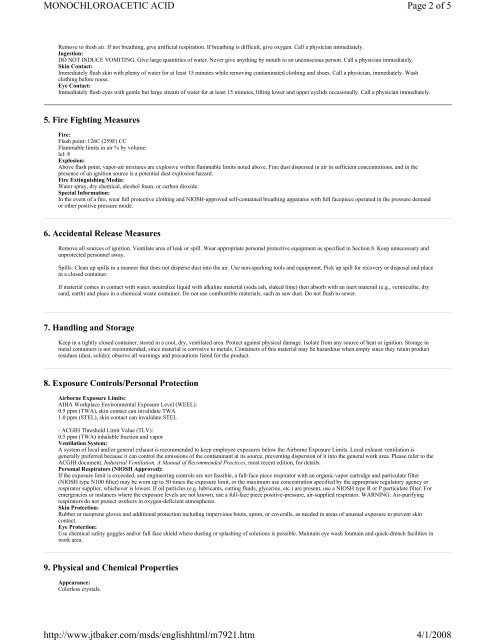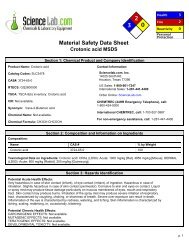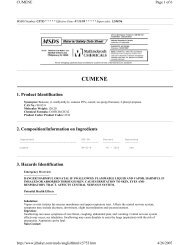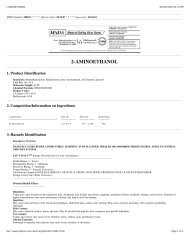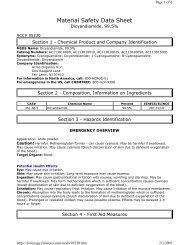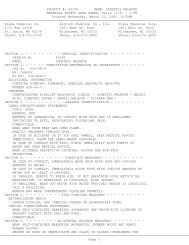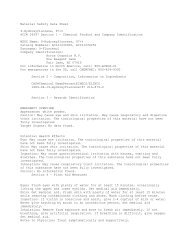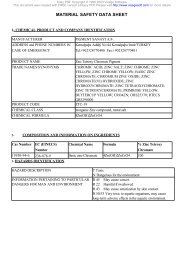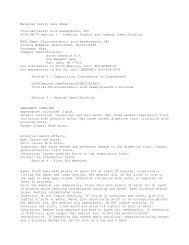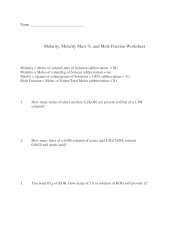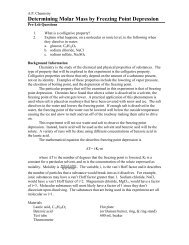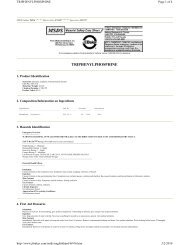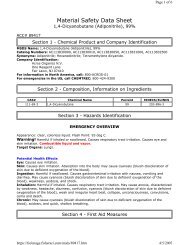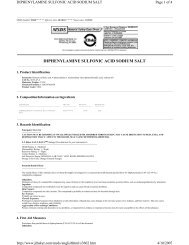MSDS PDF/M/MONOCHLOROACETIC ACID.pdf
MSDS PDF/M/MONOCHLOROACETIC ACID.pdf
MSDS PDF/M/MONOCHLOROACETIC ACID.pdf
You also want an ePaper? Increase the reach of your titles
YUMPU automatically turns print PDFs into web optimized ePapers that Google loves.
<strong>MONOCHLOROACETIC</strong> <strong>ACID</strong>http://www.jtbaker.com/msds/englishhtml/m7921.htmPage 2 of 54/1/2008Remove to fresh air. If not breathing, give artificial respiration. If breathing is difficult, give oxygen. Call a physician immediately.Ingestion:DO NOT INDUCE VOMITING. Give large quantities of water. Never give anything by mouth to an unconscious person. Call a physician immediately.Skin Contact:Immediately flush skin with plenty of water for at least 15 minutes while removing contaminated clothing and shoes. Call a physician, immediately. Washclothing before reuse.Eye Contact:Immediately flush eyes with gentle but large stream of water for at least 15 minutes, lifting lower and upper eyelids occasionally. Call a physician immediately.5. Fire Fighting MeasuresFire:Flash point: 126C (259F) CCFlammable limits in air % by volume:lel: 8Explosion:Above flash point, vapor-air mixtures are explosive within flammable limits noted above. Fine dust dispersed in air in sufficient concentrations, and in thepresence of an ignition source is a potential dust explosion hazard.Fire Extinguishing Media:Water spray, dry chemical, alcohol foam, or carbon dioxide.Special Information:In the event of a fire, wear full protective clothing and NIOSH-approved self-contained breathing apparatus with full facepiece operated in the pressure demandor other positive pressure mode.6. Accidental Release MeasuresRemove all sources of ignition. Ventilate area of leak or spill. Wear appropriate personal protective equipment as specified in Section 8. Keep unnecessary andunprotected personnel away.Spills: Clean up spills in a manner that does not disperse dust into the air. Use non-sparking tools and equipment. Pick up spill for recovery or disposal and placein a closed container.If material comes in contact with water, neutralize liquid with alkaline material (soda ash, slaked lime) then absorb with an inert materail (e.g., vermiculite, drysand, earth) and place in a chemical waste container. Do not use combustible materials, such as saw dust. Do not flush to sewer.7. Handling and StorageKeep in a tightly closed container, stored in a cool, dry, ventilated area. Protect against physical damage. Isolate from any source of heat or ignition. Storage inmetal containers is not recommended, since material is corrosive to metals. Containers of this material may be hazardous when empty since they retain productresidues (dust, solids); observe all warnings and precautions listed for the product.8. Exposure Controls/Personal ProtectionAirborne Exposure Limits:AIHA Workplace Environmental Exposure Level (WEEL):0.5 ppm (TWA), skin contact can invalidate TWA1.0 ppm (STEL), skin contact can invalidate STEL- ACGIH Threshold Limit Value (TLV):0.5 ppm (TWA) inhalable fraction and vaporVentilation System:A system of local and/or general exhaust is recommended to keep employee exposures below the Airborne Exposure Limits. Local exhaust ventilation isgenerally preferred because it can control the emissions of the contaminant at its source, preventing dispersion of it into the general work area. Please refer to theACGIH document, Industrial Ventilation, A Manual of Recommended Practices, most recent edition, for details.Personal Respirators (NIOSH Approved):If the exposure limit is exceeded, and engineering controls are not feasible, a full-face piece respirator with an organic vapor cartridge and particulate filter(NIOSH type N100 filter) may be worn up to 50 times the exposure limit, or the maximum use concentration specified by the appropriate regulatory agency orrespirator supplier, whichever is lowest. If oil particles (e.g. lubricants, cutting fluids, glycerine, etc.) are present, use a NIOSH type R or P particulate filter. Foremergencies or instances where the exposure levels are not known, use a full-face piece positive-pressure, air-supplied respirator. WARNING: Air-purifyingrespirators do not protect workers in oxygen-deficient atmospheres.Skin Protection:Rubber or neoprene gloves and additional protection including impervious boots, apron, or coveralls, as needed in areas of unusual exposure to prevent skincontact.Eye Protection:Use chemical safety goggles and/or full face shield where dusting or splashing of solutions is possible. Maintain eye wash fountain and quick-drench facilities inwork area.9. Physical and Chemical PropertiesAppearance:Colorless crystals.


